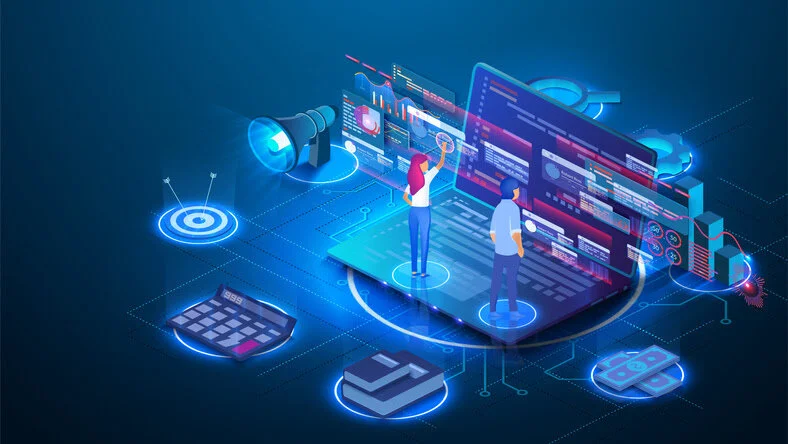Can A Digital First Strategy Give You A Competitive Edge?
The business shift to digital has accelerated since the global pandemic began, according to a 2020 McKinsey report. In North America, 60% of products and services are partially or fully digitized. More employers are accepting remote work arrangements, and many customers have come to expect “socially distanced” options even for services traditionally provided face-to-face. Many of these changes will become permanent. And companies that want to maintain a competitive advantage are eagerly developing digital first business strategies.
What is digital first?
Providing easy ways to purchase products online, find FAQs on a website, or meet with business representatives via Zoom are all part of a digital first strategy. In a broader sense, a digital first business strategy “digitizes” business processes and customer interactions whenever possible and sometimes in unexpected ways such as using AI to answer customer questions or using a kiosk to check-in customers instead. Let’s take a look at a few ways companies might digitize their business.
Websites
The company website may seem like the most obvious place where a digital first strategy might begin but many businesses underutilize their website. Here are just a few ways you can leverage your website in your digital first strategy:
Video tutorials. If there is something you want to teach your clients, create a simple video and upload it to your website.
Media information. Has your company been featured in the news? Create a page that can house all of that information. Include links to articles, video interviews, and podcasts. And even if you’ve never been featured in the news, when something good happens in your business, write a short press release and post it on the “news” page of your website.
Online scheduler. Do you take a lot of meetings with clients? If so, there are some free (and paid) tools out there that automate scheduling. Tools like Calendly integrate into your website and have free versions.
FAQs. If you’ve been in business long enough, you probably have a good stack of frequently asked questions (FAQs). If so, create an FAQ page to make it easy for customers to get some basic questions answered.
But implementing a digital-first strategy doesn’t end with optimizing your website. There are quite a few new tools available.
AI Chatbots
Just about everyone has encountered an AI chatbot on Amazon or some other online shop. You request your package tracking or other data, and within seconds a list of recent purchases appears. These computer programs are designed to streamline and improve the customer experience. According to Juniper Research, chatbots saved businesses $165 million in 2019. Fortunately, the benefits of chatbots aren’t just reserved for large companies, mid-sized and small businesses can find affordable systems for as little as $50/month.
An important distinction should be made between a standard chatbot and an AI chatbot. A standard chatbot allows the business to preprogram specific information that will be shared when prompted by specific user requests (e.g. FAQs) while an AI chatbot is a machine that can learn and provide completely unique and personalized answers. A standard chatbot might be used to access an extensive FAQ database. This is especially useful if there are hundreds or thousands of frequently asked questions a business would like to efficiently answer whenever a customer asks via the company website. On the other hand, if you want to provide answers to more complex questions or questions you didn’t preprogram, an AI chatbot would have the ability to provide that service. Here’s a video explanation of chatbots.
Kiosks
Airports have them. Malls have them. Kiosks are almost everywhere. Need to print your airline boarding pass? Just use the kiosk. Need to locate your favorite shop in a 30,000 square foot mall? You should use a kiosk. Kiosks are convenient for customers and profitable for businesses, especially in high traffic areas. Here are some ways any business can leverage kiosks:
Provide information about services, products, special deals, or events.
Allow customers to print materials such as a ticket, flyer or coupon.
Help customers get on a waitlist at a busy restaurant.
Check-in or check-out of any service-based business. This works well for restaurants and hotels but it can also work for any business with a lot of customer meetings such as a consulting firm or doctor’s office.
Take the temperature of guests before they enter your business.
Provide a digitized clock-in system for hourly workers.
More than just another fancy technology, kiosks save time and money by automating many administrative duties.
In the future, kiosks may become as ubiquitous as cash registers. In Pasadena, CA, some restaurants and retailers have established the first “pay-by-face” network where kiosks scan a customer’s face to unlock their digital wallet.
QR Codes (QRC)
QRC is a two-dimensional barcode developed in the 1990s by a Japanese automotive company. It’s been around for a long time but it’s only recently become as common as a business card in some sectors. You can use QR codes to share almost any kind of data that can be stored on a website. It’s not the data that is stored in the code but the link to that data. Just point your camera phone at the QRC and you will automatically be taken to the link. QRCs are often used to quickly share a website address that might include text, audio, images, video or even an augmented reality experience. It’s really easy to use QRCs in your business, all you need is information on a web address and a QRC generator.
Robots
Robots are officially playing a bigger role in businesses everywhere. Some hospitals use robots to perform intricate surgeries that are minimally invasive. Factories use robots for monotonous and repetitive tasks. And now the restaurant industry is using robots to serve customers at SEATAC airport – delivering food right to the gate. It’s true that using robots in any part of your business can come with some pretty hefty upfront costs, but the long-term labor cost savings far outweigh the expense. Even if you’re not in the market to hire a robot today, you should begin to assess which repetitive, low-skill tasks in your business could be better handled by a machine. As some large companies turn to robots to fill their labor gap, smaller companies will be forced to adapt if they want to remain relevant and competitive in their industry.
Seattle Bankruptcy Attorneys
Contact the experienced Seattle bankruptcy and business law attorneys at West Coast Bankruptcy Law today at (206) 724-0846 to discuss your financial situation.



